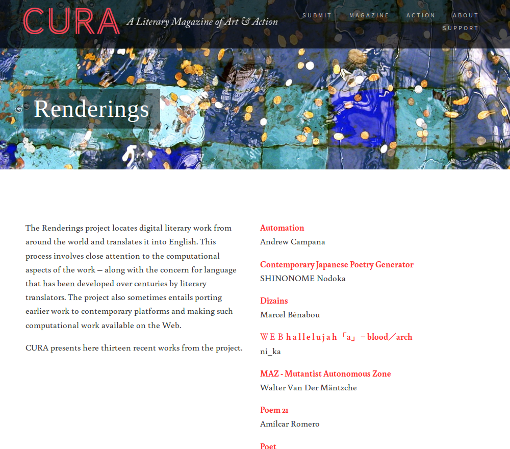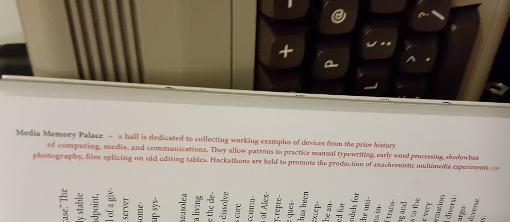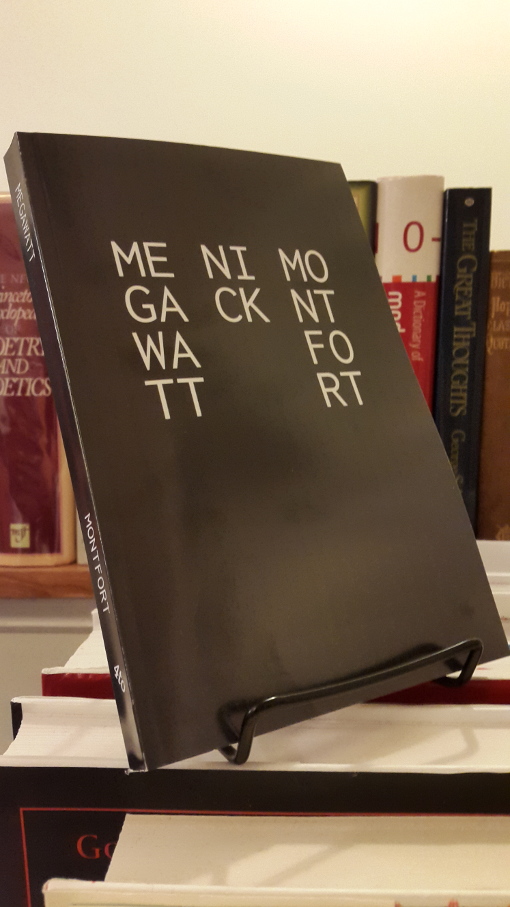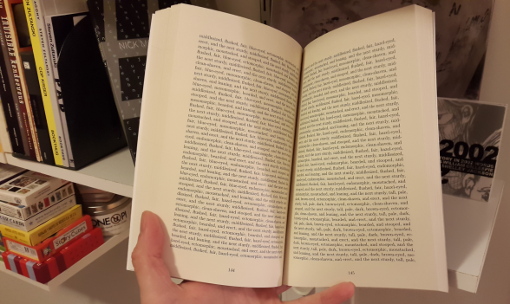There were so many excellent novel generators, and generated novels, last month for NaNaGenMo (National Novel Generation Month).
I thought a lot of them related to and carried on the work of wonderful existing literary projects — usually in the form of existing books. And this is in no way a backhanded complement. My own NaNoGenMo entry was the most rooted in an existing novel; I simply computationally re-implemented Samuel Beckett’s novel Watt (or at least the parts of it that were most illegible and computational), in my novel generator Megawatt (its PDF output is also available). For good measure, Megawatt is completely deterministic; although someone might choose to modify it and generate different things, as it stands it generates exactly one novel. So, for me to say that I was reminded of a great book when I saw a particular generator is pure praise.
Early in month, Liza Daly’s Seraphs set a high standard and must have discouraged many offhand generators! Liza’s generator seeks images and randomizes text to produce a lengthy book that is like the Voynich Manuscript, and certainly also like the Codex Seraphinianus.
Allison Parrish’s I Waded in Clear Water is a novel based on dream interpretations. Of course, it reminds me of 10,000 Dreams Interpreted (and I am pleased, thanks to my students from long ago, to have the leading site on the Web for that famous book) but it also reminds me of footnote-heavy novels such as Infinite Jest. Let me note that a Twine game has already been written based on this work: Fowl are Foul, by Jacqueline Lott.
I found Zarkonnen’s Moebius Tentacle; Or the Space-Octopus oddly compelling. It was created by simple substitution of strings from Moby-Dick (one novel it clearly reminded me of), freeing the story to be about the pursuit of an octopus by space amazons. It wasn’t as polished as I would have liked (just a text file for output), and didn’t render text flawlessly, but still, the result was amazing. Consider how the near-final text presents the (transformed) Tashtego in his final tumult:
A sky-hawk that
tauntingly had followed the main-truck downwards from its unnatural home
among the stars, pecking at the flag, and incommoding Lazerbot-9 there;
this spacebat now chanced to intercept its broad fluttering wing between the
hammer and the plasteel; and simultaneously feeling that etherial thrill,
the submerged robot beneath, in her death-gasp, kept her hammer frozen
there; and so the spacebat of heaven, with archangelic shrieks, and her
imperial beak thrust upwards, and her whole captive form folded in the
flag of Vixena, went away with her spaceship, which, like Satan, would not sink
to transwarp till she had dragged a living part of heaven along with her, and
helmeted herself with it.
Sean Barrett wrote two beautiful generators (at least) – the first of which was How Hannah Solved The Twelve-Disk Tower of Hanoi. Deliberate, progressing, intelligent, and keeping the reader on the edge of her seat – this one is great. But, that generator (drafted by November 9) wasn’t enough, and Barrett also contributed (only a day late) The Basketball Game, an opera generator that provides a score (with lyrics) and MIDI files. It’s as if “I got Philip Glass!” indicates that one is rebounding.
Eric Stayton’s I Sing Of takes the beginning of the Aeneid as grist, moving through alternate invocations using WordNet. I like the way different epics are invoked by the slight changes, and was reminded of Calvino’s If on a winter’s night a traveler.
Sam Coppini’s D’ksuban Dictionary, although also just a text file, is a simple but effective generator of a fictional language’s dictionary. Less like the Devil’s Dictionary, more like the (apparently unpublished) lexicon of Earth: Final Conflict. I’m sure literary works in D’ksuban will be forthcoming soon.
Ben Kybartas’s Something, Somewhere is wonderfully spare and evocative – more Madsen than Hemingway.
Finally, Thricedotted’s The Seeker is an extraordinary concrete novel in the tradition of Raymond Federman’s Double or Nothing. The text, based on wikiHow, is good and serves well to define a protagonist who always wishes to do right, but the typographical framework is really excellent.
These are just a few comments before NaNoGenMo goes as stale as a late-December pumpkin. I hope you enjoy tis work and other work that was done last month, and that you keep an eye peeled for further novel generators – next November and throughout the year.





